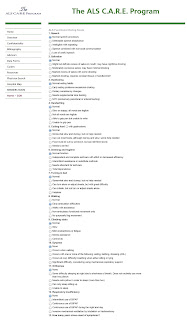So back in early March I went to my first ALS Clinic. At that time the only thing going on with any
impact on me was some left foot clumsiness.
This meant I walked more slowly and by this time I had stopped running.
When I first went to the clinic they had me fill out the ALS
Functional Rating Scale-Revised which can be used to predict survival
time. Here’s a copy of my ALSFRSR at
that time:
And here’s my score plotted on a survival curve:
The first clinician I met at the ALS Clinic in March with was the
Respiratory Therapist. He performed Pulmonary
Function Tests (PFTs) on
me. Interestingly in all my years
attending in the hospital I never had a PFT test, although I had seen a number
of them done. To make a long story short
– the Forced Vital Capacity (FVC) is the
most important test. This test is done
by breathing into a tube – taking the biggest breath you can, the exhaling as
much and as long as you can. It sounds
easy but it’s remarkably hard. It took
me 4-5 tries before we got a good result.
The reason why the FVC is important is that people with ALS die from
respiratory failure because the muscle that help you breath stop working. ALS has very few therapies which extend your
life. There are currently really only
two – a drug called Riluzole (Rilutek) which extends
life by an average of 2 months, and using BIPAP at night
(it’s similar to CPAP). BIPAP extends
life by 18 months on average. When your
FVC gets to about 50% of predicted, they put you on BIPAP.
Well the good news was that my FVC was 110% of normal – possibly due
to my running.
Other things that were covered in the clinic included the natural
course of the disease, the need for possible Voice Banking, ordering a cane as
well as an AFO, and
started me on the medication Riluzole.
At end of the visit they scheduled to return in three months to
check how thing were progressing – that follow up clinic visit occurred earlier
this week. I’ll post an update soon
about my most recent ALS Clinic visit.


No comments:
Post a Comment